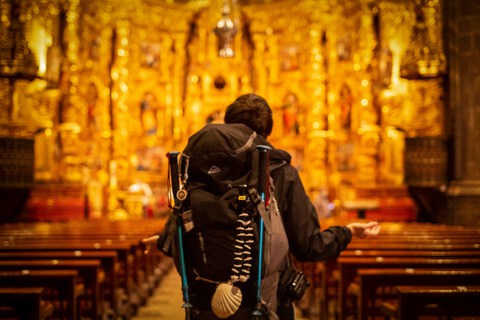The history of the Camino
The Camino, also known as the Camino de Santiago or the Way of St. James, is a historic pilgrimage route that has been traveled for centuries. It holds great religious and cultural significance for those who undertake the journey.
Let's explore the history of the Camino
The Camino de Santiago, a revered pilgrimage route with a rich tapestry of historical, cultural, and spiritual significance, traces its origins back to the 9th century. It was during this time that the purported remains of St. James the Apostle were discovered in what is now Santiago de Compostela, Spain. This monumental discovery transformed the city into a pivotal pilgrimage destination, drawing countless devout from across Europe.
The early pilgrimages
The first recorded pilgrimage to Santiago de Compostela dates to 950 AD when the bishop of Le Puy-en-Velay in France ventured to the sacred site. His journey set a precedent that would see the Camino grow in popularity over the ensuing centuries. As its fame spread, a network of routes sprang up across Europe, forging spiritual pathways that linked disparate regions with Santiago de Compostela.
The camino in the middle ages
By the Middle Ages, the Camino had ascended to the zenith of its importance, standing alongside Jerusalem and Rome as one of Christianity's three most esteemed pilgrimages. More than a mere religious journey, the Camino was a vibrant conduit for social, cultural, and economic exchange. It knitted together a diverse tapestry of people from various backgrounds, facilitating a rich exchange of ideas, cultural practices, and goods.

Cathedral de Santiago de Compostela
Decline and revival
Despite its early prominence, the Camino's allure waned towards the end of the Middle Ages. Political turbulence, religious upheavals, and the emergence of new trade routes all contributed to its decline. However, the 20th century heralded a revival of this historic route, spurred by concerted efforts from both the Spanish government and the Catholic Church to restore and promote the pilgrimage.
The camino today
Today, the Camino de Santiago is recognized as a UNESCO World Heritage Site and continues to captivate thousands of pilgrims from around the globe each year. The most famed route, the Camino Francés, starts in the French Pyrenees and stretches roughly 780 kilometers (480 miles) to Santiago de Compostela. However, other routes like the Camino del Norte and the Camino Portugués offer alternative paths through the stunning landscapes and rich cultural tapestries of northern Spain and Portugal, respectively.
A journey of many motivations
Modern pilgrims embark on the Camino for myriad reasons. Some seek spiritual enlightenment or a reconnection with their faith, while others are drawn by the allure of adventure, the challenge of the trek, or a profound desire for personal transformation. The journey offers an unparalleled opportunity to immerse oneself in nature, explore historic sites, and engage with diverse cultures.
"Regardless of the motivations behind the journey, completing the Camino is often seen as a transformative experience for pilgrims, fostering a sense of camaraderie, self-discovery, and a deeper understanding of the world and oneself."
Transformation
No matter the initial motivation, completing the Camino is often a profoundly transformative experience. It fosters a deep sense of camaraderie among travelers, catalyzes self-discovery, and enhances one's understanding of the world. Pilgrims frequently return from the Camino changed, carrying with them not just memories of the landscapes they traversed, but also insights into themselves and the bonds they forged along the way.
The history of the Camino de Santiago is a vivid narrative of faith, resilience, and transformation—a journey that continues to inspire and challenge those who walk its paths. Whether undertaken for spiritual, personal, or cultural reasons, the Camino remains a journey at the heart of countless stories of discovery and enlightenment.